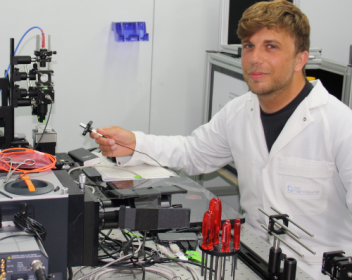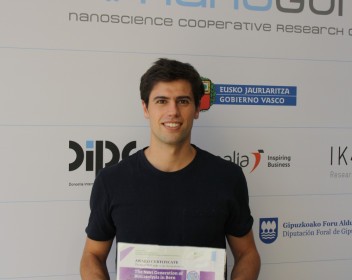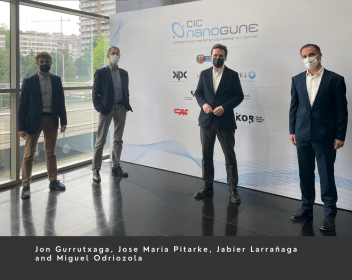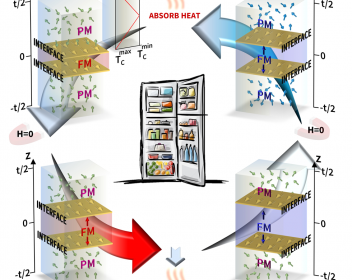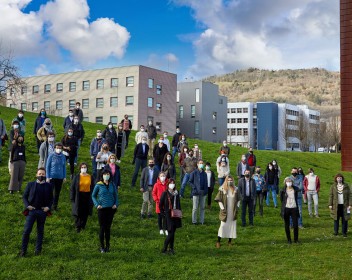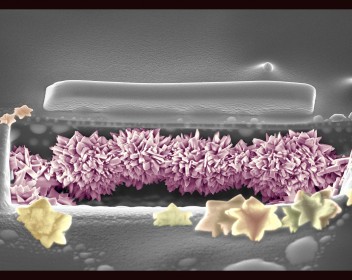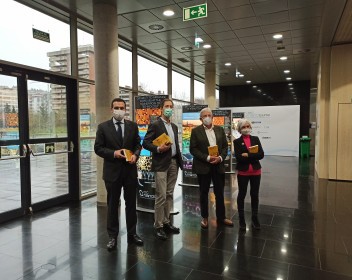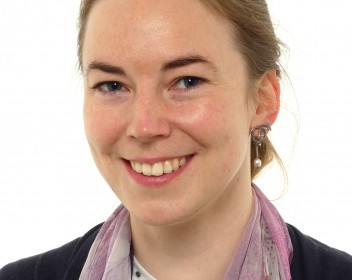Sala de prensa
Noticias
PhD Thesis: Self-assembly and optical properties of gold nanoparticle superlattices for surface-enhanced Raman spectroscopy
Mathias Charconnet, early stage researcher of the Nanoengineering Group at nanoGUNE, has defended his PhD thesis Today at the University of the Basque Country.
Andoni Rodriguez-Abetxuko, best PhD talk at NG Biocatalysis Symposium
Andoni Rodriguez-Abetxuko got the best PhD talk award in the Next Generation of Biocatalysis Symposium that took place in Bern & virtually on 27-28 May 2021.
Visita de representantes de la Diputación Foral
Dr. Lorenzo Fallarino has been recently nominated as Emerging Leader in Applied Physics
Dr. Lorenzo Fallarino, researcher in CIC nanoGUNE´s Nanomagnetism group, has been recently invited by the Editorial Board of Journal of Physics D: Applied Physics to publish a Topical Review on "Graded Magnetic Materials" and separately, he was nominated to contribute to a special issue of the journal highlighting the accomplishments of Emerging Leaders in the field of Applied Physics. Both invited articles have now been published.
Fèlix Casanova recibe el Premio Intel al Investigador Destacado 2020
El investigador Ikerbasque Fèlix Casanova, el líder del grupo de Nanodispositivos de nanoGUNE, ha sido recientemente galardonado con el Premio Intel al Investigador Destacado 2020, por sus contribuciones en la tecnología MESO, una tecnología que mira a las necesidades de los dispositivos electrónicos del futuro.
Una investigación de CIC nanoGUNE sobre la luz, portada en la revista Nature Photonics
Investigadores del CIC nanoGUNE, en colaboración con el Donostia International Physics Center (DIPC) y la Universidad de Oviedo, emplearon una técnica de nanoimagen espectroscópica para estudiar cómo interactúan la nanoluz infrarroja -en forma de polaritones fonónicos- y las vibraciones moleculares. El trabajo ocupa ahora la portada del mes de marzo de la prestigiosa revista Nature Photonics.
Más mujeres con ciencia
Los centros de investigación Donostia International Physics Center (DIPC), CIC nanoGUNE, el Centro de Física de Materiales (CFM CSIC-UPV/EHU), CIC biomaGUNE, Biodonostia, Tecnun-Escuela de Ingeniería, Ceit, POLYMAT, Elhuyar, la Facultad de Informática de la UPV/EHU y Eureka! Zientzia Museoa se han unido para presentar una programación conjunta con motivo del Día Internacional de la Mujer y la Niña en la Ciencia que se celebra a nivel internacional el 11 de febrero en todo el mundo. A partir de ese día y en Donostia, la programación de Emakumeak Zientzian 2021 se extenderá a lo largo de todo el mes de febrero con talleres, charlas públicas, experimentos en familia, visitas virtuales… adaptadas en gran parte al formato virtual debido a la emergencia sanitaria. El objetivo de la iniciativa es hacer visible la actividad de las mujeres en ciencia, romper con los roles típicamente masculinos atribuidos a las actividades científico-técnicas, y fomentar la elección de carreras científicas entre niñas y adolescentes. Emakumeak Zientzian 2021 cuenta con el apoyo de la Diputación Foral de Gipuzkoa, Fomento San Sebastián, el Consejo Superior de Investigaciones Científicas (CSIC) y la Fundación Española de Ciencia y Tecnología (FECYT).
2021 nanoGUNE PhD Workshop: where do art and science meet?
NanoGUNE, el gran reto de lo pequeño
CIC nanoGUNE ha presentado esta mañana un libro, "NanoGUNE, txikiaren xarma", que recoge la creación y desarrollo del centro de investigación desde sus inicios. El objetivo del libro es socializar cómo se lleva a cabo investigación puntera en el campo de la nanociencia y la nanotecnología. ¿Cómo se concreta cada día “ El gran reto de lo pequeño”? ¿Cómo se puede llevar a cabo un proyecto realmente innovador y valiente? A esta pregunta responde este relato.
Naëmi Leo receives the Hertha Sponer Prize
Agenda
| Lun | Mar | Mié | Jue | Vie | Sáb | Dom |
|---|---|---|---|---|---|---|
|
1
|
2
|
3
|
4
|
5
|
6
|
7
|
|
|
|
|
|
|
|
|
|
8
|
10
|
11
|
12
|
13
|
14
|
|
|
|
|
|
|
|
|
|
|
15
|
16
|
17
|
18
|
19
|
20
|
21
|
|
|
|
|
|
|
|
|
|
22
|
23
|
24
|
25
|
26
|
27
|
28
|
|
|
|
|
|
|
|
|
|
29
|
30
|
31
|
1
|
2
|
3
|
4
|
|
|
|
|
|
|
|
|
Eventos
- 04/02/2026 al 06/02/2026
nanoGUNE Winter School 2026
nanoTECA
Encuentra fotos, imágenes experimentales, vídeos, audios y elementos de la imagen corporativa de nanoGUNE.

